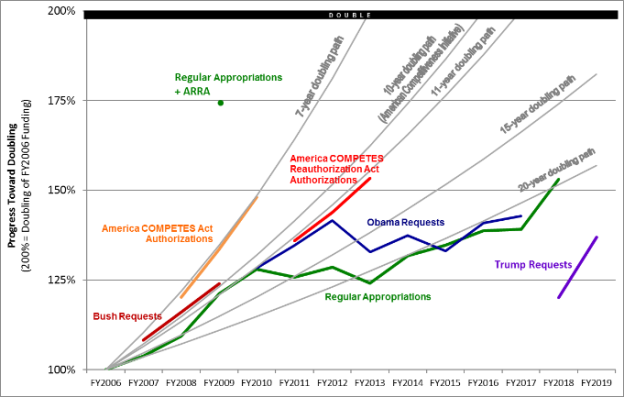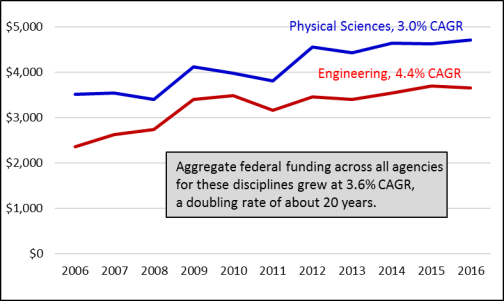Revisiting the Doubling Effort: Trends in Federal Funding for Basic Research in the Physical Sciences and Engineering
The adequacy of federal investment in physical sciences and engineering (PS&E) basic research is a long-standing concern of many in industry and academia. This topic received much attention in the early 2000s due to perceived underinvestment in these disciplines. Many Members of Congress, industry leaders, and science and technology policy analysts asserted that the long-term competitive position and national security of the United States depended in large measure on the rapid increases in federal funding for PS&E. PS&E research provides the foundation for materials, products, and manufacturing technologies spanning a wide range of industries, including automotive, chemicals, semiconductors, electronics, telecommunications, aerospace, defense, and pharmaceuticals.
Stakeholder interest in increasing federal PSE funding was further fueled by the doubling of funding for life sciences research at the National Institutes of Health (NIH) from FY1998 to FY2003. Although the NIH doubling had broad support, some subsequently expressed concerns that it had created an imbalance in the federal research portfolio that undervalued PS&E research and might reduce the number of students choosing to pursue PS&E graduate degrees.
Momentum toward a doubling effort for PS&E research was catalyzed by a 2005 National Academies report, Rising Above the Gathering Storm: Energizing and Employing America for a Brighter Economic Future (RAGS). The report, requested by several Members of Congress, recommended doubling federal basic research funding over seven years, emphasizing fields such as the physical sciences and engineering.
In 2006, President George W. Bush launched the American Competitiveness Initiative (ACI), which sought to increase federal funding for PS&E research by doubling funding over 10 years for targeted accounts at the National Science Foundation (NSF), the Department of Energy (DOE), and Department of Commerce (DOC). The targeted accounts included all NSF accounts, the DOE Office of Science, and the National Institute of Standards and Technology's Scientific and Technical Research and Services (STRS) and Construction of Research Facilities (CRF) accounts with DOC. Since Congress provides appropriations for agencies and programs, not for particular fields of science and engineering, these PS&E-focused accounts served as surrogates for the effort.
In 2007, Congress passed the America COMPETES Act (COMPETES 2007, P.L. 110-69), which authorized funding for the accounts identified in the ACI for FY2008-FY2010. In aggregate, the FY2010 authorized amounts represented a compound annual growth rate (CAGR) of 10.3% over the FY2006 level (a growth rate that would result in doubling in seven years if this growth rate were sustained). Actual appropriations were lower than the authorized levels, with actual FY2010 appropriations corresponding to a 6.4% CAGR over FY2006 (a doubling pace of 11 years).
Concerns that gave rise to the America COMPETES Act had not subsided when the act's authorizations of appropriations expired. Congress sought to address these ongoing concerns with enactment of the America COMPETES Reauthorization Act of 2010 (COMPETES 2010, P.L. 111-358). Congressional support for COMPETES 2010 lacked the wider bicameral consensus enjoyed by COMPETES 2007. While COMPETES 2010 passed the Senate by unanimous consent, the House vote on the final bill was 228-130, in large measure because of the bill's proposed increases in authorized spending for FY2010-FY2013. Like COMPETES 2007, a pillar of COMPETES 2010 was increased funding for the targeted accounts. Authorizations for FY2013 represented a 6.5% CAGR over FY2006, a doubling pace of approximately 11 years. Actual FY2013 appropriations, however, were lower than the authorized level and even below the FY2010 appropriations level. Actual FY2013 appropriations represented a 3.1% CAGR from FY2006, a doubling pace of 22 years—more than triple the length of time originally envisioned in COMPETES 2007 and twice as long as the COMPETES 2010 doubling pace.
|
Figure 1. Funding for Accounts Targeted for Doubling: Appropriations, Authorizations, and Requests (FY2006-FY2019) versus Selected Doubling Rates budget authority, current dollars |
 |
|
Source: Prepared by CRS based on data from agency budget justifications, annual appropriations acts, ARRA, COMPETES 2007, and COMPETES 2010. Note: ARRA = American Recovery and Reinvestment Act of 20019 (P.L. 111-5) |
Figure 1 shows authorizations, budget requests, and appropriations since FY2006 as a percentage of their FY2006 funding level and how they compare to different doubling rates. The thick black line at the top of the chart is at 200%, the doubling level. The data used in Figure 1 are in current dollars, and do not reflect the effect of inflation on the purchasing power of these funds.
Figure 2 illustrates the progress made toward the underlying goal of increasing federal PS&E basic research funding. Total federal PS&E basic research grew at a 3.6% CAGR from FY2006 to FY2016, with engineering research growing at a 4.4% CAGR and physical sciences research growing at a 3.0% CAGR.
Despite repeated efforts in Congress, the targeted accounts have not been reauthorized since the expiration of the COMPETES 2010 authorizations. From FY2013 to FY2018, funding grew at 4.3% CAGR. The compound annual growth rate between FY2006 and FY2018 is 3.6%, a nearly 20-year doubling pace—slower than envisioned in RAGS, the ACI, COMPETES 2007, and COMPETES 2010.
While some policymakers have continued to advocate for a doubling approach or even faster increases for specific agencies (for example, see H.R. 1569 and S. 641), other advocates for increased funding for basic research have moved away from using the "doubling" framework as the appropriate goal for such increases, asserting instead that "sustained and predictable" federal funding is a better framework (for example, see H.R. 1806).
Given current concerns about U.S. competitiveness, driven in part by China's rapid increases in research and development funding, Congress may consider the effects of the doubling effort on total federal PS&E research funding trends, impediments to achieving the doubling target, the role of increased funding for basic research in advancing national competitiveness, the current competitive position of U.S. industries that depend on physical sciences and engineering research, and how commercial competitiveness concerns can best be addressed by the federal government.
